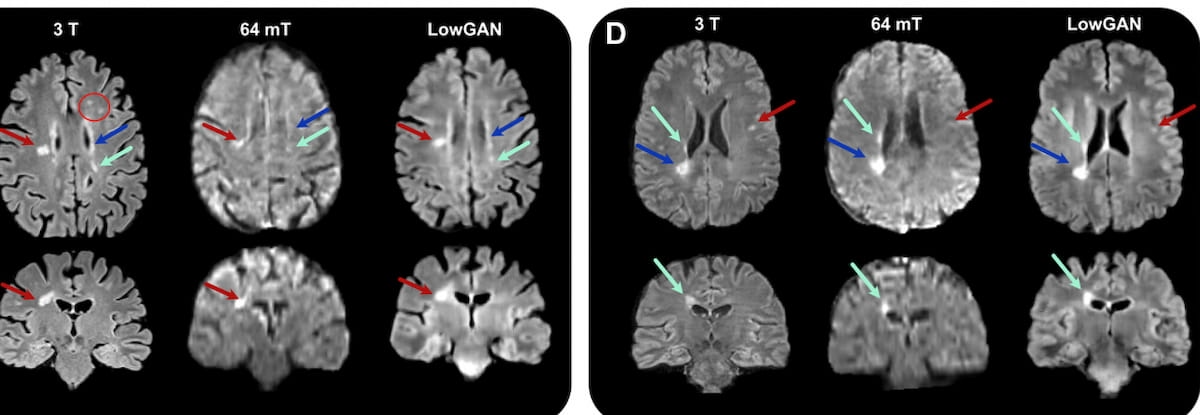An emerging deep learning model, which employs generative adversarial network architecture to obtain synthesized high-field-strength magnetic resonance imaging (MRI) views from low-field strength MRI inputs, may facilitate portable MRI assessment of patients with multiple sclerosis (MS).
For the observational study, recently published in Radiology, researchers developed and evaluated the generative adversarial network architecture (lowGAN) model in a total cohort of 63 patients with MS who had portable low-field MRI (64-mT) and conventional 3T MRI scans.
The study authors found that the LowGAN model increased Dice similarity coefficient (DSC) scores for segmentation of white matter lesions in contrast to 64-mT MRI.
Noting exceptions with the structural similarity index (SSIM) and feature similarity index (FSI) on T2-weighted MRI (T2-MRI), the researchers found that LowGAN provided improved SSIM, peak signal-to-noise ratio (PSNR), normalized cross-correlation (NCC) and the FSIM in comparison to 64-mT MRI across T1-weighted MRI, T2-MRI, and fluid-attenuated inversion recovery (FLAIR) sequences.
“Our results demonstrate that LowGAN better preserves lesion characteristics, reduces background noise, and enhances lesion-like features, potentially increasing diagnostic accuracy,” wrote lead study author Alfredo Lucas, who is affiliated with the Perelman School of Medicine and the Department of Bioengineering at the Center for Neuroengineering and Therapeutics at the University of Pennsylvania, and colleagues.
The researchers also noted comparable cerebral cortex volumes between the LowGAN model and 3T MRI assessment (483.6 cm3 vs. 482.1 cm3).
Three Key Takeaways
1. Improved lesion detection. The LowGAN model enhances white matter lesion visualization by increasing Dice similarity coefficients, improving diagnostic accuracy in patients with multiple sclerosis (MS) using low-field (64-mT) portable MRI.
2. Enhanced image quality. LowGAN improves image quality metrics such as SSIM, PSNR, and FSIM across various MRI sequences (T1, T2, and FLAIR), preserving lesion characteristics and reducing background noise compared to standard low-field MRI.
3. Accurate brain morphometry. The model closely approximates 3T MRI in measuring cerebral cortex and thalamic volumes, potentially supporting its utility for brain morphometry and neurodegeneration monitoring in MS.
Emphasizing that recent studies have shown the significance of thalamic atrophy as a key marker for neurodegeneration, the researchers said the the LowGAN model enables assessment of this marker in patients with MS.
“Our findings show that LowGAN effectively recapitulates 3-T thalamic and ventricular volumes, improving measurement accuracy for brain morphometry,” maintained Lucas and colleagues.
(Editor’s note: For related content, see “AI Software for Brain MRI Gets Expanded FDA Clearance for Multiple Sclerosis Assessment,” “FDA Clears Updated Software for Faster Low-Field MRI Brain Scans” and “Study Says Low-Field MRI Offers Sufficient Diagnostic Quality for Detecting Spinal Pathology.”)
In regard to study limitations, the authors acknowledged the relatively small dataset and conceded that the combination of high and low field strength MRI pairs in the training of LowGAN may limit the use of the generative adversarial network architecture across different types of scanners. The researchers added that LowGAN can’t generate lesions or diagnostic detail beyond what is present on 64-mT images.
